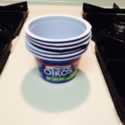ViolaAnn said:I guess the thing we should really be talking about is the (re)use of of yogurt cups to start seeds. I think it's a great idea and I've also done it for years.
Sound like the large fork could also make holes in several cups at once. I'd venture to guess I could find a used one at the Sally Ann store near me.
Sharpening the tines helps a lot.
It also helps to put the cup on a block of styrofoam or on top of a juice glass and punch through the bottom while the cup is supported from underneath, but where the punch has space (or foam that it can penetrate).
I usually only poke holes through one or two cups at a time. It's just easier to push through that way, and a lot easier to pull back out. With a bigger stack, sharp tines will go in fairly easily, but the cups shift and grab and it's very hard to pull your "punch tool" back out of all the layers.
greene said:  For the good information about dioxins.
For the good information about dioxins.
You're welcome.
greene said:I was agreeing with the person who uses an electric drill. Mine was a positive post. I did not say that dioxins would be released only that they could ...  but thanks for jumping on this. Lots of folks will benefit from such a detailed and informative post.
but thanks for jumping on this. Lots of folks will benefit from such a detailed and informative post. 

The point of my post is you
couldn't get dioxins from burning a yogurt cup. Only
chlorinated plastics can release dioxins (and PCB's, and other chlorinated "really bad, toxic stuff") when burned.
Most yogurt cups are made of polypropylene. I see the original post of this article shows pictures of a polystyrene yogurt cup, with a "6" in the recycling triangle and the letters "PS". I didn't know that yogurt was ever put in containers made of polystyrene, I wouldn't eat from a container made of that. Neither polypropylene nor polystyrene contain chlorine, so neither will release "dioxins" or other toxic chlorinated compounds when burned. Just like you can't build a brick house if all you have are logs, you can't get chlorinated "dioxins" if all you have to burn is hydrogen, carbon and oxygen.
Actually, most recycled polypropylene (and a lot of recycled LDPE) goes into artificial fireplace logs. So, in the real world, people burn used (recycled) yogurt cups (and milk jugs and other food containers with "4" or "5" in the recycle symbol) all the time.
Really, I don't mean to jump on you. I just get frustrated when I see misinformation repeated and passed along as though it's a fact. Misinformation like "burning
any plastic releases dioxins," which is a mostly false statement.
greene said:By the way, I burned my thumb today just lifting up a glass that held a burning candle  ...which is another good reason that I avoid things like hot nails and melty plastic.
...which is another good reason that I avoid things like hot nails and melty plastic. 
I can't help you there. I would suggest a sharpened fork or nail to poke holes in your yogurt cups, but even those can be dangerous.

For the good information about dioxins.
but thanks for jumping on this. Lots of folks will benefit from such a detailed and informative post.


...which is another good reason that I avoid things like hot nails and melty plastic.
